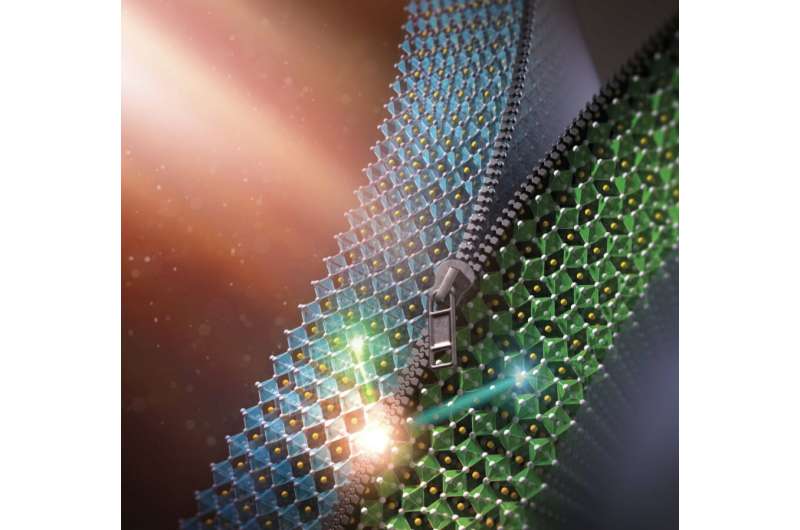November 29, 2022 feature
Researchers realize perovskite-based phase heterojunction solar cells

Over the past few decades, engineers and material scientists have created increasingly advanced and efficient solar technologies. Some of these technologies are based on photovoltaics with a so-called heterojunction structure, which entails the integration of two materials with distinct optoelectronic properties.
Researchers at Technische Universität Dresden have recently realized a different type of solar cells, referred to as phase heterojunction (PHJ) solar cells. These cells, introduced in a paper published in Nature Energy, were fabricated using two polymorphs (i.e., structural forms) of the same material, the perovskite CsPbI3, instead of two entirely different semiconductors.
"The realization of a PHJ requires the ability to fabricate two different phases of the same perovskite composition on top of each other," Yana Vaynzof, lead author of the paper, told TechXplore. "While the fabrication of ?-phase CsPbI3 perovskite by solution-processing is well established in the literature, we needed to develop a method to deposit a ?-phase perovskite without dissolving the underlying ?-phase layer, so we decided to use thermal evaporation for this purpose."
In one of their previous studies, Vaynzof and her team devised a strategy to evaporate ?-phase CsPbI3 perovskites by heating them. This strategy proved to be crucial for the experimental realization of their new PHJ solar cells.
"PHJs exploit the fact that the specific arrangement of atoms/molecules in crystalline materials (i.e., the material's phase) may lead to the emergence of different properties," Vaynzof explained. "This is indeed the case with ? and ?-phase CsPbI3 perovskites, since ? phase results in a larger bandgap than the ? phase. Based on their different properties, interfacing the two phases in a heterojunction can be used to create a beneficial energetic landscape for the photogenerated charges in the photovoltaic device, and by doing so improve the photovoltaic performance."
To create their PHJ solar cell, Vaynzof and her students had to deposit the two material phases so that they were one on top of the other. This was achieved using a series of complementary deposition techniques.
"We chose to deposit the bottom ?-phase by solution-processing, and the top ?-phase by thermal evaporation, which ensured the formation of a sharp interface between the two layers and is compatible with processing at relatively low temperatures," Vaynzof said. "Ours is the first demonstration of the phase heterojunction as a novel concept for photovoltaics."
The recent work by this team of researchers could open interesting possibilities for the creation of new PHJ photovoltaic technologies, which differ significantly from those available today. As many semiconductor materials exhibit polymorphism (i.e., the ability to exist in different crystalline phases), the same method used to create this PHJ solar cell could be applied to other perovskites and other semiconducting materials with different properties.
In their next studies, Vaynzof and her team will continue working on innovative solar energy solutions. For instance, they now plan to develop strategies that would allow them to control the phases of perovskite materials, as this could enhance their PHJ solar cell design further.
"These strategies will allow us to explore different phase heterojunction configurations for different perovskite compositions and integrate them into various photovoltaic device architectures," Vaynzof added. "Importantly, we aim to utilize only thermal evaporation as the deposition method in order to enable the fabrication of multi-layered structures without the limitations that arise from the use of solvents in solution processing. Considering that thermal evaporation is a highly scalable, industrially relevant method, this will facilitate the future integration of phase heterojunction into industrial applications."
More information: Ran Ji et al, Perovskite phase heterojunction solar cells, Nature Energy (2022). DOI: 10.1038/s41560-022-01154-y
Zongbao Zhang et al, Efficient Thermally Evaporated γ‐CsPbI 3 Perovskite Solar Cells, Advanced Energy Materials (2021). DOI: 10.1002/aenm.202100299
© 2022 Science X Network


















